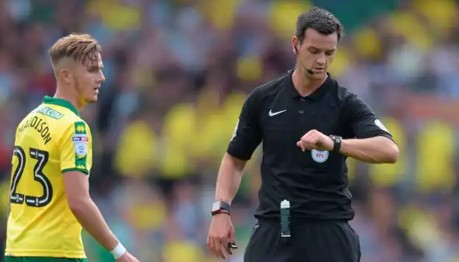Replace Manual Time Tracking
With a Digital Countdown Clock

Part of the job?
The center referee’s primary responsibility is to enforce the rules of the game, not to be a timekeeper. Let an assigned timekeeper take care of timekeeping. This is one less major headache for the officials to be concerned about. Almost every weekend in the top professional leagues, there’s a situation where the referee extends time beyond the suggested number of added minutes to allow for a corner kick, free kick, or throw-in. More often than not, the team that’s granted this “grace period” ends up tying or winning the game, when a digital countdown system would have already ended the match.
The number of minutes of extra time added is supposed to be a function of all the interruptions that occurred during the half, caused by substitutions, injuries, VAR checks, and field disruptions. But there’s no need for all this complex math if we simply employ a digital countdown clock and a timekeeper who stops it when necessary.
In college soccer, a stoppage of the clock occurs specifically when the referee blows the whistle for a substitution, water break, injury situation, or an unexpected disruption (weather-related, impostors, fights, etc.). The referee also uses a hand signal in the form of a letter “T” to tell the timekeeper to stop the clock. We’ve all seen it before.
The clock resumes its countdown when the referee blows his whistle, once again making eye contact with the timekeeper before signaling the player on the ball to take the restart (throw-in, direct kick, indirect kick, or drop-ball). This system works fairly well, but the clock keeps ticking away after the whistle is blown for a foul or after the ball leaves the field of play. Even with a digital countdown system such as this, players waste precious seconds by delaying restarts or feigning injury, often intentionally.
The key question is: when should the timekeeper stop and resume the countdown clock? I propose stopping the clock in 2 specific situations: (a) whenever the ball exits the field and is not in play, or (b) when the center referee blows the whistle for a foul, for a direct or indirect kick, or a disruption in the stands or on the field. Situation (a): the ball is “in play” when it is in motion (either on the ground or in the air) within the perimeter of the pitch. The clock should be stopped as soon as the ball leaves the field and is no longer “in play” (according to this definition). This time management rule saves precious seconds while players wait for a ball to be retrieved, when a goalkeeper dilly-dallies to take a goal kick, when players dawdle while throwing the ball in, or when a player feigns injury to kill time. As soon as the ball leaves the perimeter of the field, the clock stops counting down. For situation (a), the timekeeper does not have to wait for the center referee’s signal to stop the clock. The timekeeper stops the clock as soon as he sees the ball leaving the field.
At the highest levels, microchips embedded in footballs will someday help determine when the ball has crossed the touchline or end-line, signifying that the ball is out of play. Timekeepers will be able to rely on a digital signal on a smartwatch to stop the clock. Until such technology is available, however, (and at lower levels of competition), the assistant referees can signal the timekeeper when the ball goes out of play.
Timekeepers must therefore pay close attention to the AR’s out-of-bounds flag signals (for throw-ins, goal kicks, and corners), and to the center referee’s signals. Since center referees typically wait for the AR to signal out-of-bounds first, the timekeeper should focus primarily on the AR’s flag signals and only refer to the center referee’s hand and arm signals for confirmation. Situation (b): if the ball stays in play, and the center referee blows the whistle for a foul, direct or indirect kick, or a field disruption, the timekeeper must also stop the clock. The referee is not obligated to show the “T-formation” hand signal as used by the NCAA and most professional leagues in North America, but can if he wants to emphasize the point that a particular stoppage may take a bit longer than usual. Once the restart is taken, and the ball is once again in motion within the perimeter of the field, the timekeeper resumes the digital countdown. Note that the timekeeper does not resume the countdown on the referee’s whistle for a restart. This is because several seconds may elapse from the time that the referee blows his whistle for the restart until the player gets the ball in motion. Why waste precious seconds in between? Only when the ball resumes motion on the field should the timekeeper press the resume countdown button on the digital time controller.
Ever consider how much time ticks away when the ball exits the field, during free kicks, throw-ins, injuries, substitutions, and VAR checks? When a goal is scored, it can take anywhere from 1 to 3 minutes for play to resume - due to excessive celebrations, VAR checks, and players getting back into position. All this while the clock is running with the current outdated time management system. Sure, the 4th official tries to tack on lost time at the end of each half, but how they calculate added time remains a mystery. Then there’s the free rein that the center referee has for making adjustments to the suggested added minutes. Bottom line is that we’re currently dealing with a haphazard time management system designed for medieval times.

The digital countdown system that I propose can shave off as much as 10 minutes of “wasted” time during games. And the best part is that there’s no more mystery about the remaining time in a match. Just look up at any scoreboard in the stadium and you’ll have your answer. We need to quit playing games by arbitrarily adjusting seconds and minutes to matches. The digital countdown system not only removes another burdensome responsibility for referees, but provides a level of transparency for everyone – for the players, coaches, and spectators.
The governing bodies should give serious thought to the implementation of such a
digital time management system. It’s transparent, infinitely more accurate than the current one, and helps reduce the possibility of bias and corruption.
What every football fan needs to know about the rules, tactics and management of the beautiful game.
Gain valuable insights and recommendations from a seasoned player, coach, and referee who has dedicated years to analyzing the sport's tactics, rules, and administrative structure.
Rich Warner’s exploration of the beauties and shortcomings of the game is direct, insightful, and eye-opening.
Discover secrets of the game you may never have considered!
Broaden your understanding of soccer with this game-changing book!
Join Richard's email list
©2025 RichardsPublishing.com | Cookie and Privacy Policy

